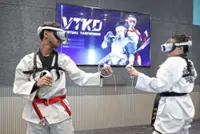Virtual reality has already made significant inroads into health care in areas like trauma therapy and surgery. The launch of Apple's Vision Pro headset could now accelerate this. — Photo: Christoph Dernbach/dpa
SAN DIEGO: Only just released to the public, Apple's new Vision Pro headset can already be used to display medical records, filling a doctor's field of view with anything from graphs of a patient's blood pressure over time to the results of their latest chest X-ray.
The expensive new technology, with its ultra high-resolution screens for each eye and multiple cameras for hand and eye tracking, brings a new level of precision to a realm that, up to this point, has mainly been the domain of video games.





